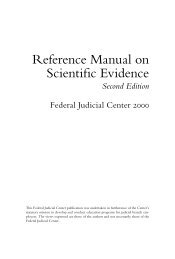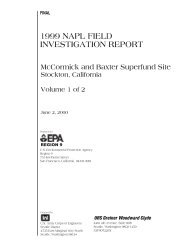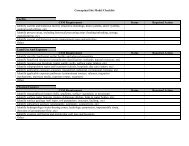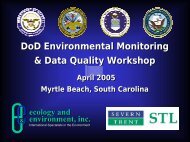Source Zone Delineation Demonstration Report - Triad Resource ...
Source Zone Delineation Demonstration Report - Triad Resource ...
Source Zone Delineation Demonstration Report - Triad Resource ...
Create successful ePaper yourself
Turn your PDF publications into a flip-book with our unique Google optimized e-Paper software.
5.2 OU 12 SVE EvaluationThe OU 12 SVE demonstration was primarily conducted to obtain additional vadose zonecharacterization data for estimating TCE distribution in the suspected source zone at OU 12 using amultiphase, multicomponent numerical model. Step tests were conducted under constant vapor flowconditions and not necessarily constant pressure as is normally performed during SVE pilot-scale studies.TCE time series data were obtained in real-time via DSTIMS and used to make decisions on when toadjust pumping operations at each extraction well. Although the step tests were optimized to assesscontaminant distribution within the vadose zone of the investigative area, the data also provide anindication of the pneumatic response of the subsurface at OU 12 during vapor extraction operations.5.2.1 Pneumatic Evaluation5.2.1.1 <strong>Zone</strong> of Pneumatic InfluenceThe pneumatic data generated during the OU 12 SVE demonstration was used to estimate the zone ofpneumatic, or pressure, influence observed during vapor extraction operations in the vadose zone at OU12. Although rather misleading, the zone of pneumatic influence is generally referred to as the radius ofinfluence (ROI), where ROI testing involves evaluating the maximum radial extent of induced subsurfacevacuum to some arbitrarily specified level (typically 0.01 inch of water) in single well tests. The ROI isdetermined by plotting vacuum as a function of logarithmically transformed radial distance and applyinglinear regression to extrapolate to the distance at which a specified vacuum would be observed.Alternatively, nonlinear regression techniques can be used to estimate the ROI from the measuredpressure versus distance data. Vacuum monitoring points are often located significant distances fromvapor extraction wells in an attempt to “physically” locate ROIs for given flow rates and to compensatefor the possible geologic variations in the subsurface.Historically, ROIs have been used as the basis of design for extraction well networks. The zone ofvacuum influence around a well also has been interpreted as corresponding to the “capture zone” of theextraction well. By subsequently selecting an arbitrary distance within this zone of vacuum influence(e.g., the radius at which the vacuum equals 0.01 inch of water vacuum), designers have established wellspacings for SVE well networks. Unfortunately, the zone of vacuum influence does not necessarilycorrespond with the capture zone of the extraction well. Vacuum profiles are typically very curvilinear,especially under conditions of high leakance of air from the surface and radial-to-vertical gas permeability(k r /k z ) ratios greater than 1.0. As shown in Figure 5-21, vacuum profiles do not consist of a series ofconcentric cylinders surrounding the well screen of the vapor extraction well as predicted based on a ROIdesign. Additionally, a ROI-based SVE design, can result in subsurface pore-gas velocities too low foroptimal gas circulation especially at low leakance values and high k r /k z ratios. The suitability of usingvacuum levels such as 0.01 inch of water, typical of ROI testing and ROI-based designs, to ensureadequate gas circulation decreases with increasing k r /k z ratios and decreasing leakance values. ROIbaseddesigns are more likely to be appropriate as k r /k z ratios approach 1.0 or less and when significantleakance occurs (EPA, 2001).March 2003 5-31 OU 12 <strong>Demonstration</strong> <strong>Report</strong>Final










